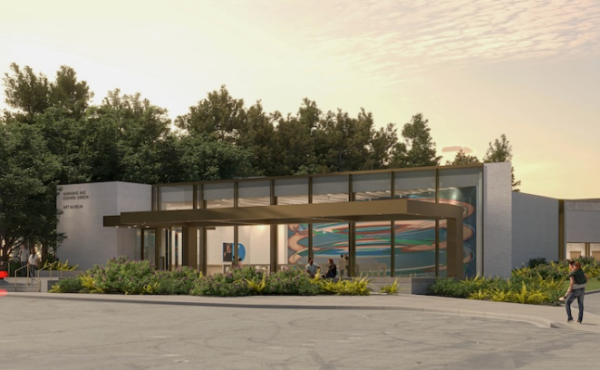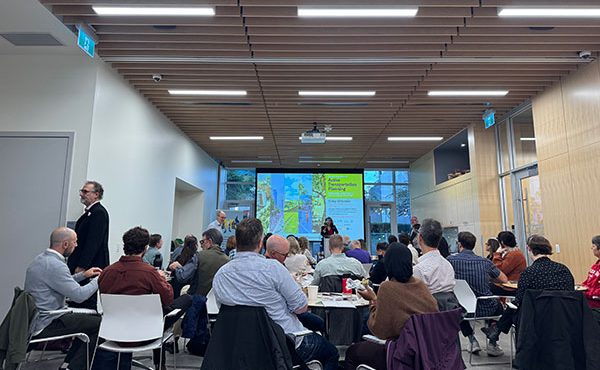 With the recent visit of Finnish architect Juhani Pallasmaa to the UBC School of Architecture (SALA), many in Vancouver’s architectural community had the pleasure of joining the seventy-three old award winning architect for an evening’s presentation of his work at the Vancouver Playhouse.
With the recent visit of Finnish architect Juhani Pallasmaa to the UBC School of Architecture (SALA), many in Vancouver’s architectural community had the pleasure of joining the seventy-three old award winning architect for an evening’s presentation of his work at the Vancouver Playhouse.
By Sean Ruthen
Every so often, a visitor to our urban shoreline has the ability to rouse us from our architectural slumber, such that our eyes are opened to the events of the world beyond our young city, to highlight the possibilities and opportunities that we may miss if we fail to adjust our architectural outlook. In recent history, one can count on their fingers the amount of visitors who have had such an effect – the people that thronged to hear Tadao Ando speak at the Chan Centre in 2005, as well as similar crowds to hear the late Arthur Erickson speak – all those present knew that they were being part of something that was ‘more than meets the eye’ (pun fully intended). For those fortunate enough to have been at the Vancouver Playhouse this past November 2nd, all were able to witness just such an architectural event. As part of the ongoing Arthur Erickson Lecture Series, Finnish architect and former professor Juhani Pallasmaa presented ‘12 Themes in My Work’ (as chosen by others he confessed) to a capacity crowd.
In his two hour presentation, the good humoured Pallasmaa gave an inspirational presentation of his life’s work and philosophy, beginning with two quotes by Ludwig Wittgenstein and Maurice Merleau-Ponty. As he posited, phenomenology and architecture have a link through the senses, and so as a point of departure he stressed the importance of this school of philosophy in his work, and the effect it has had on the body of work being presented over the course of the evening. One of his prefacing quotes summed up his comprehension of his life’s work: “Shortly before (a man) dies, he discovers that this patient labyrinth of lines is a drawing of his own face.” As presented, the ’12 Themes’ are a visage of his own unique architectural expression – different but similarly idiosyncratic to that of his fellow countryman Alvar Aalto, and imbued with the curiousity of the philosophers, artists, and poets who for ages have sought to understand the structures of the mind through the truth of the senses.
Following these opening remarks, Juhani emphasized the importance of his writing as a way to test his ideas throughout his career, and then as an aside remarked how he had just been told by one of the lecture’s organizers that one of his books had recently been translated into Mandarin and Farsi (he didn’t know). Along with his Encounters: Architectural Essays (2005) and The Thinking Hand (2009), The Eyes of the Skin (2005) is revolutionary in its ambition to overthrow the hegemony of the eye, what Pallasmaa calls the ocularcentric paradigm, with a total perception of our physical environments through our senses. So profound an impact has this remarkable book had that its teachings have been incorporated into architectural design studios the world over, espousing the relationship of humanity to architecture as an act of sensual totality, much in the same spirit as the architecture of Peter Zumthor and the already mentioned Alvar Aalto.
It goes without saying that Pallasmaa’s influence has been far-reaching, whether disseminated through the numerous lectures he has given the world over, or in his writing, influencing the likes of Steven Holl and the Patkaus. To purport a theory of architecture that dethrones the eye is almost as unimaginable as suggesting a form of music in which the ear plays second fiddle, yet such a paradigm shift in our increasingly facile and flat modernist expression in the West, the result of too many years of accountant’s architecture designed by P3’s and committees, is exactly the usurpation that could rouse our imaginations to a new philosophy of the built environment, transcending discussions of fashion, computer technology, and even sustainability (which itself has become a new fashion). It is a new beat from a new drum, and as made evident by the full-house assembled to hear him speak, it would appear many are listening.
Not since Gaston Bachelard has such a sophisticated thinking mind had such a radical shift in mindset mid-career. For Bachelard, a natural scientist who became a phenomenologist, he turned his scientific precision inwards to explore the notion of oneirism, or the dreams by which we comprehend our waking perceptions, all posited in his extraordinary book ‘The Poetics of Space’. Similarly for Pallasmaa, his early work was epitomized by a rationalist ‘Constructivism’ which epitomized the national architectural style of his day, itself a curious combination of Japanese jointery amalgamated with the functionalism of the International Style. It would be later in his life however when Pallasmaa would find his own distinct voice, casting off technology and fashion for the simplicity of craft and tactile exploration. And for all his wisdom and learning, in the end he confesses that his understanding of the relationship of architecture to culture to be one of uncertainty and insecurity, as it is left to our senses to assemble it into the coherent narrative we call history.
And so then to the ‘12 themes’ of Pallasmaa’s work, with the architect giving examples from his largest buildings to his most intimate sculpture, from the graphic design he did as a youth to the large corporate and civic projects of his later career. In the order he presented them, the 12 elements are:
1. continuous line
2. penetration
3. circle and arc
4. joint
5. touch
6. material and colour
7. scale
8. light
9. landscape
10. stairway
11. column
12. time
As would be expected, the projects selected to demonstrate his 12 themes draw upon a rich body of work, ranging from the very personal – his father’s gravestone – to the very public. For the ‘continuous line’, he marvels at how Matisse was able to capture the essence of a woman’s form through a few curving lines. As an example in his own work, Pallasmaa presented an artist’s summer house that he designed for the continuous line of the horizon seen from the house’s living areas, combined with the arc of the sunlight that annually plays upon the house’s southern exposure. As an example of ‘joint’ he presented a summer pavilion he built next to the Villa Mairea in 1968, where he created a structure around a connection, reminiscent of Mies’ Barcelona Pavilion in its modular elegance.
The fifth theme in his presentation was one he felt to be far too absent from modern architecture – ‘touch’. And so he presented a collection of door handles, which he humourously referred to as a building’s handshake, exhibited at the 1991 Venice Biennale. In an other exhibition, he covered the entire exhibit space floor with four inches of sand. Tactility, he reminded us, is an experience that we have at one to one scale. For ‘colour and materiality’, Pallasmaa showed us a public space in Helsiniki painted with a Mediterranean colour palette, which he discovered has the uncanny effect of drawing his Finnish kin ‘out of the forest’ as he put it, as they believe they’re in southern sunnier climates.
For the seventh element – ‘scale’ – Pallasmaa showed a series of paired images, with one image large and one small – a massive Helsinki development next to a design for fireplace implements, a phone both paired with a monumental bank office block he did in Moscow (for which he said then president Yeltsin gave him ‘a big box of money’). The smallest scale project he ever did was a design he did for a gold coin commemorating Finnish composer Jean Sibelius, with his largest being the aforementioned International Moscow Bank Headquarters (1990), comprised of the bank and its offices, as well as a shopping arcade and public plaza. In both cases, he pointed out, the design problem starts the process of exploration from the same origin.
It is not surprising that Pallasmaa holds the eighth theme –‘light’ – as sacred, believing no other element able to evoke an emotional response, whether grief or ecstasy, so intensely and definitively. As an example, he presented to the audience a project that perhaps represented one of his proudest moments – when five of his architecture students had their design selected for the Finnish Pavilion at the 1992 World’s Fair in Seville. With Pallasmaa as their captain for overseeing the construction of the design, the professor and students realized a splendid pavilion of materiality and light, for which Juhani did the interiors. A more recent addition to Finland’s architectural legacy, Steven Holl’s Kiasma Museum of Contemporary Arts in Helsinki, completed in 1998, is another powerful evocation of ‘light’, as well as a fitting example of the ‘landscape’ theme, as Pallasmaa was commissioned to work with Holl to realize the museum’s exterior spaces.
For the ‘stairway’ theme, the architect has done many studies of stairs in numerous media, though he refers to these sculptures as ‘architectural objects’. Along with a stairway turned on its side and sculpted in ice and snow, Pallasmaa’s fascination with this architectural object reminds one of the impossible staircases of M.C. Escher. But it was the final themes, ‘column’ and ‘time’, which provided the elements for what he believes to be his most profound project to date – the Driveway Square he did for the Cranbrook Academy of Art in Michigan. With the campus having originally been designed by another renowned Finnish architect, Eliel Saarinen (it had seen recent additions by both Rafael Moneo and Steven Holl among others), so was Pallasmaa asked to contribute, providing a scheme to sew together an amalgam of disparate spaces in the centre of the campus.
His charge would be not a building however, but an entry court and public plaza, in which he used a combination of the Fibonacci series with a sundial, as defined by the path of the sun across the plaza. Six columns of decreasing heights, made from glacial materials indigenous to the site, define the project at the end of a T-intersection. The layout acts as both a sundial and astral calendar, prompting one astronomer friend of his to exclaim that he had created a ‘dashboard for the universe’. But the most humourous moment in the design came when Pallasmaa attempted to have a manhole in the plaza relocated. Being told the cost to do so would be exorbitant, he first thought to put a reproduction of one of Hieronymus Bosch’s paintings upon it, instead deciding to engrave the distance beneath the manhole that one would have to travel to reach the other side of the planet (12,000 kilometers) and where one would end up (the Indian Ocean).
In the end, the audience was left with his sense of playfulness, of mystery, and a sense of awe at the accomplishments of this humble man. Ending his presentation with two quotes from the poet Rainer Maria Rilke and two images, one a painting of quiet introspect, the other a graphic image from the climax of a Peter Greenaway film, his inspirational words, especially of the importance of drawing – that the hand draws the mind and not the other way around – all of this wisdom is sure to stay with us for some time. As introduced by Kasian president Don Kasian, Christopher Macdonald, and John Patkau, this event will surely be remebered as one of the highlights of this year’s Arthur Erickson Lecture Series.
***
Sean Ruthen is an architect working, living, and writing in Vancouver.



